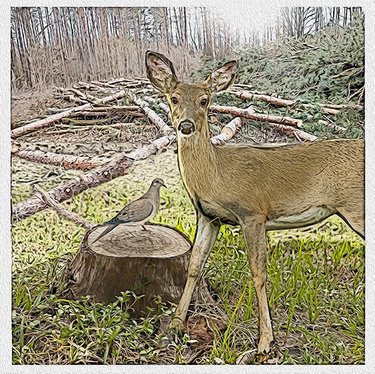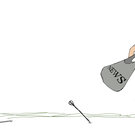We need a Stop sign at the intersection of development and preservation
We are adding our voice to the voices of citizens who earlier this month called on the Guilderland Town Board to adopt a moratorium while the town charts its future.
There is a public imperative for this and also a personal one.
The public reason was well stated by residents at the Jan. 10 town board meeting.
Gerd Beckmann said correctly that the town is at a crossroads. “Let us not lose the rural nature and the beauty that makes up the town of Guilderland,” he said.
Beckmann listed several new subdivisions underway and the complaints they had engendered. He cited problems, not just of tree cutting, but of traffic, safety, and water availability.
His comments were applauded by neighbors in the gallery who were there to protest trees being felled on acres that had long been untouched on the outskirts of Altamont near the village’s Bozenkill Park.
Guilderland is wise to update its 20-year-old comprehensive land-use plan as development pressures — both commercial and residential — increase. Many municipalities — including recently the nearby towns of Bethlehem and Westerlo — have enacted moratoriums while they update plans or create laws to give those plans teeth.
This is a sensible course to follow. It will give the committee some breathing room and the town planner who supports their work a chance to focus on the future rather than feverishly keeping up with the development plans of the present.
Another citizen who spoke out on Jan. 10, Chuck Klaer, had served on the town’s original comprehensive plan committee and later served on the zoning board. He asked about the law to protect trees that the town board passed in December, and Supervisor Peter Barber responded that a committee will be appointed to develop a forestry plan for the town and then bring that to the town board.
If the law had been adopted a year ago, Barber said, it might apply to the current tree-cutting problem but the new law “probably wouldn’t add much more in terms of financial or the ability to get injunctive relief that doesn’t already exist” under state environmental and stormwater regulations.
Klaer suggested “having a lengthy enough moratorium to give that law a chance to get some legs underneath it and some procedures and protections rather then let all this destruction take place only to be, ‘Oh, if only we had this in place.’”
Some Armstrong Drive residents spoke to The Enterprise on Dec. 29, the day the tree-felling issue came to a head.
We understood their frustration. Since their lovely homes were built, they had what amounted to a nature preserve in their backyard.
One of those residents, Dr. Bill Root, put it eloquently in a letter to the Enterprise editor, “We’re going to fight for this piece of paradise”: “This unique acreage has it all,” Root wrote, “ancient farmland long left to go fallow, running streams with their attendant wetland and stately old growth, with many huge oaks that stand to stabilize the gentle hills that feed the streams ….
“Of course there are deer and coyotes, turkeys, raccoons, skunks, groundhogs, and more. The woods is visited by bobcats and bears that makes the neighborhood buzz with excitement. The bats zip around the neighborhood sky all summer long, madly keeping the skeeters from the wetland in check.”
Paradise, indeed. And we don’t blame the Roots and their neighbors for fighting for it. But here’s the rub: None of them own that land. It is owned by Richard Friedlander who planned to sell it to developer Jason Zappia.
State and town requirements were not followed when the logging began. The property was to have first gone through a state environmental review process as well as through Guilderland’s planning process before the trees were felled.
The town board voted on Jan. 3 to suspend planning board review of Zappia’s subdivision and also to authorize the town attorney to seek injunctive relief, issuing a restraining order, if need be.
The temporary halt is just that — temporary. It doesn’t solve the larger problem. Unless land is owned by someone or some entity — a municipality or a conservancy, for example — or unless a property owner has secured a conservation easement, that property, within zoning limits, can be developed.
The more Guilderland grows, the more neighbors will be distressed to lose what Beckmann termed the town’s rural nature and beauty. That’s where the planning committee and the need for a moratorium comes in.
The current tree-felling is exceptional — Supervisor Barber, who chaired the zoning board for 16 years before becoming supervisor, said he’d never encountered anything like it — because the developer didn’t follow the proper procedure. But, had the property not been slated for development, without the current forestry law in place, there would have been nothing to stop the felling of trees.
Here’s where the personal part comes in.
I had written two articles on the trees being felled — the first about cease-and-desist orders being ignored, and the second about the town board’s response. The first two cease-and-desist orders were sent by the town to the developer, Zappia, and his engineer.
A third order, which got results, was also sent to the logger, René Savoie, and to the landowner who had hired the logger.
Savoie, who runs a small logging company with just his brother, wanted me to see his work. He gallantly raised me on the blade of his skidder so I could sit atop the hood and, from eight or 10 feet up, survey the woods as he carefully drove along the logging roads he and his brother had built.
I could see the white tails of deer flash through the fallow fields that Root had described. I could also see the tree stands hunters had constructed. I heard about a man who told Savoie he had walked his dog in those woods for 30 years and was wary of the loggers felling trees.
The hunting and the dog-walking of course were taking place on private land, not in a public park.
I learned a lot from Savoie and tried to share it as best I could with our readers. Savoie told me that property owners frequently have their land logged, to get the value of the timber, before they sell it. I learned that the most the brothers could fell in a day were eight to 10 trees not the 25 to 30 neighbors thought they heard.
I saw the corduroy bridge constructed of felled sycamore trees so that the waters of the Black Creek could flow free and clear. And I called the Department of Environmental Conservation to learn this was a recommended practice, not illegal, as a neighbor had said.
In fact, I learned that the DEC had issued no violations for the logging.
I learned that the wedges the neighbors heard were used by the Savoie brothers to get the trees to fall so that they would do the least damage to other trees. And that, rather than clear-cutting, the Savooies aimed to take down older trees, leaving the younger ones to grow.
I saw the pride Savoie takes in his work. He leaves the forest clean, clearing out the treetops that can’t be sold for lumber and stacking them for firewood or pulp. I talked to one of his satisfied customers and learned Savoie has the nickname “Mr. Clean.”
Savoie sees trees as a crop, one that is harvested for needed materials. And Guilderland’s new forestry law, we’re pleased to note, allows for the responsible practice of logging. The new law says that more than an acre of land cannot be cleared unless it is done with an approved plan or permit or is “part of a recognized agricultural or sustainable forestry practice.”
Where this story became personal is in the harm I felt I had caused Savoie. I told him one of my favorite thoughts, from journalist Walter Lippmann: “The theory of a free press is that the truth will emerge from free reporting and free discussion, not that it will be presented perfectly and instantly in any one account.”
I had reported that the first two cease-and-desist orders had not included Savoie but I had not fully realized the harm that had caused. While waiting for the truth to emerge, Savoie had been hurt.
I believed Savoie when he told me the first inkling he had that anything was awry was when a police officer approached him at work on Dec. 29 and said there was a complaint.
Savoie did as he was asked that day by a DEC officer and stopped cutting. But his small business has all of its equipment tied up at a site where he now can’t finish the job he was hired to do.
“Right now, I’m losing over $10,000 a month …,” Savoie said. “If I don’t take those logs to market, I don’t have any income. As of December 29th, I have not taken in a dime. I still have mortgage and insurance payments.”
Our story about Savoie was posted last Tuesday, Jan. 17. Savoie got some small reprieve the next day when he met with the town planner who told him he could remove the $10,000 or so worth of lumber he had already cut. Savoie has to wait, though, until the ground is hard enough to move it.
But the larger dilemma remains.
As a DEC spokeswoman described it, “On a phone call with Mr. Savoie, DEC staff described Mr. Savoie as being subject to an apparent miscommunication between the town, the developer, and the landowner.”
Kenneth Kovalchik put it more directly. The town planner said of Savoie, “Unfortunately he got caught in the middle of a bad situation.”
It is unfortunate, indeed. And that is another good reason for a moratorium — so that people, like Savoie, don’t get hurt in the crossfire.
Once the new forestry law has, as Klaer said, some legs under it, with a committee appointed and a forestry plan drawn up and, at the same time, once the planning committee has presented its work to the town board, the rules will be clear to everyone.
I, myself, walk my dog most every day along a country road near my house. That land, which is privately owned, was recently subdivided. When houses instead of hay or corn sprout there, I will mightily miss the call of the mourning dove and the deer that we startle on our walks.
Is it too much to ask of a land-use plan to save some of the rural beauty many of us who live in Guilderland value? A moratorium would give citizens and planners alike a chance to ponder that question and perhaps reach consensus on an answer.



Cutting down the old trees and leaving the young trees may sound like a good idea to the loggers but not to me. Trees are so much more than a "crop'. If 75% of New York's trees hadn't been cut down 100 years ago, we wouldn't have to go to the Adirondacks to see some 350-year-old trees. Most of New York looks like it's only been here for 60 years because it's all second or third growth! We are slowly realizing we need trees to make oxygen so we can breathe. There are new programs where landowners are paid to NOT CUT DOWN THEIR TREES and we had better get on board while we still have some trees left. A stand of big old trees captures so much more polluting carbon than the two or three 2' ft treelings in the "landscaped" developments that replace it. Who's making the decisions around here anyway?